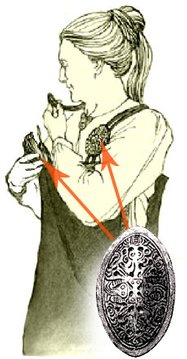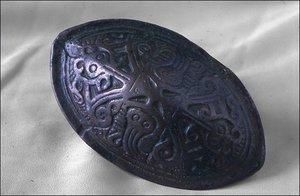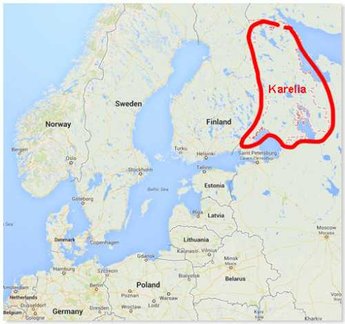Finnic or Finno-Ugric oval brooch from the Viking Age
This very fine oval brooch - 76 mm, 31 grams - shown in its actual size - can be dated to app. the 10th century. A super magnified image can be seen here.
It has a low relief decoration of Borre-style interlaced beasts with four prominent heads to the centre, catchplate to the reserve. Consulted Barry Ager - formerly curator Early Middle Ages at the British Museum responded when consulted: 'It appears to be a Finno-Ugrian imitation of the Viking oval brooch of around the 10th century. From the Gulf of Finland/Lake Ladoga region perhaps..'
James Graham-Campbell considers 'it's not 'proper' Borre style, although obviously under the influence'.
The findspot of the brooch is regrettably unknown, but must be addressed to this area.
This interesting article from a metal detectorist shows that this type of oval brooches are found in the Finnic/Karelian/Northern Russian area. They differ in size and sometimes somewhat in decoration, but the two octopus images on the left and right of the centre top of the brooch are a returning feature. The smaller size of the oval brooch and the single shell are characteristics from the Baltic / Finno-Ugrian area. The double shelled elaborate oval brooches are purely Scandinavian. Though, not pure viking in the sence of the word, these smaller oval brooches are distinct from the Viking Age.
In the museum of South-Karelia in Finland a similar example can be seen. Its description says: 'Oval tortoise brooche of bronze, found at the Kauksila burial ground. Oval clasps were used to fasten the woman's outfit at the shoulders and also to carry a heavy jewellry arrangement. Large oval brooches with acanthus-pattern ornamentation were used in Karelian areas at the times of the crusades'.(see image
This specific type is published in several books / publications.
A reference is made to Arbman H, Birka, Uppsala, 1940, Taf. 60, item 4a (page 72 of 310) wich book can be seen online here: http://historiska.se/birka/digitala-resurser/filer/pdf/Birka_I_Tafeln.pdf
although the brooch published here has some same Borre alike characteristics, it is a different style of brooch and far more distinct Scandinavian in its nature.
Another reference is given to Petersen's J., Vikingetidens Smykker, Stavanger, 1928, p. 55, fig. 48, 49 http://imgur.com/DPg3QnF
but this is also a pre Scandinavian (double shelled) oval brooch with ala Borre style decoration.
Far better references can be found within:
Sedov, B.B. Finno-Ugri i Balti v Epokhi Srednevekovija, Moscow, 1987, photo plate 3 next to page 48, drawing 33 on p. 261
Spirgis, R. Tortoise brooches with pectoral chain ornaments and the development of Liv culture in the lower Daugava area in the 10th - 13th century (Riga, 2008). p. 63, photo and drawing 20 (although this is a more elaborate executed example wich appeared to be part of a greater adornment. See also: https://www.academia.edu/4535889/The_Liv_oval_brooches_their_origins_and_the_development_of_the_ornamentation_Humanities_and_social_sciences_Latvia._Art_Applied_Art_and_Symbols_in_Latvian_Archaeology._R%C4%ABga_2003._Vol._2_39_p._77_95
About the development of shoulder brooches (with their chain arrangements) more can be read in Pirkko-Liisa Lethosalo-Hilander's Ancient Finnic Costumes. (p. 56).
Oval brooches from Tavastia, Finland.
Oval brooch found at the Kauskila burial ground.(photo: South Karelian Museum/Finland).
Video on ancient Finnish costumes and the way jewellry was worn.
Well. I could have been with these stones until after dark, but as my wife wanted to travel on.. well.. I see you again, some day, hogback stones from Gosforth. And if you happen to be there one day, do not forget that monument on the outside...
Further on with the Cumbrian hogbacktour !
In - yes, luckily again in - St. Peter's church in Heysham, there is a truly beautiful hogback stone. The guide told us, it had been studyied by Thor Ewing, a writer, in 2000. in 'Understanding the Heysham hogback' A tenth century sculpted stone monument and its context (link), Thor Ewing tells in detail what he dicovered on the both sides of this hogback stone.
Just being brought in the church as late as the 1970's accompanied with some protest here and there among the church visitors, considered as being a token of old paganism, it had been remarkably nice preserved, and a lot of detail can be seen, still. Truly worthwile a visit.
I had a small debate with the guide in the church if the - zoomorphic, in my opinion - faces on the sides were lions (or hippo's). The guide doubted if the vikings could have known about lions. Well I guess so, concerning the runes on the Ancient Greek lion statue at the Arsenal, Venice. For example. Vikings did travel south..
But when he told me he was doubting the vikings 'discovered' (as the native inhabitants were of course, in the first place) America before Columbus, I decided to rest my case..
One has to know when to start and to end a conversation ..
Just discovered the book in a bookstore written by Geoff Holder - The guide to the mysterious Lake District, I knew there had to be another hogback stone in Lowther, St. Micheal's Church. With a promising image described in the text of 'a naval and a land-based force of shield-bearing vikings above a fish and what might be a coiled sea serpent. On the reverse is a row of female figures with snakes, possibly a representation of the hideous hag Hel'. Wow. If that did not sound as a true pagan promised land ..
Not complaing too much after all we have seen, this visit was the dissapointing one of them all. But if you wife states 'I am happy to have seen them' and I am answering 'Measuring is knowing' and the even more obligate verb 'handling 'if we did not see it at all, we wouldn't have known anything at all of how they were looking' the glass was again half full, at the last day of our journey..
The hogback stone appeared to be just being tolerated within the entrance segment part of the church. As something you never use anymore but you do not throw away - entirely. That sort of feeling emerged when seeing this hogback asylum seekers.. Bed, bath and bread, ás we say in Dutch, but no luxury at all and standing on some outcuts of wood, you would balance the table with at home..
Come on, St. Micheal's Church.. care a bit more of your 'children' !
This hogback stone was moved in the church in 1907. Hogback stones layed partially buried in the churchyard before it was dug up and moved into the church.
The promising depiction of a longship - as certainly can be seen after some studying - see http://vikingminds.co.uk/pages/longship
we have missed !
The stone itself is (157 x 50 x 30 cm) and very worn.
The hogback stones in Cumbria - very diverse in quality, but everyone worth a visit ! Especially on a gloomy day in late October ...
The churches to visit - see photos of resp. St. Andrew's church in Penrith, St. Mary's church in Gosforth, St. Peter's church in Heysham and St. Micheal's church in Lowther.
Did I miss out on another one in Cumbria ? Let me know !
In a next blog I will take you to four - still remaining utterly mysterious- statues 'guarding' the graveyard of St. Andrew's church in Dacre..
For the last blog of October 9th see this link.
References: (as always, links to where the books can be ordered are attached).
Edwards, B.J.N. Vikings in North West England - The artifacts (1998);
Emery, Gordon, CURIOUS CUMBRIA, The Lake District & Beyond: A celebration of Cumbria (2023)
Ewing, T. 'Understanding the Heysham hogback' A tenth century sculpted stone monument and its context ;
Hall, R. Viking Age archaeology in Britain and Ireland (first printed 1990, reprinted with amendments in 1995);
Holder, G. The guide to the mysterious Lake District (2009)
possibly also (as there within the part of Cumbria dealing with Carlisle, the Eden Valley, Barrow-in-Furness, Whitehaven and the west coast is being dealed with)
Holder, G. Paranormal Cumbria (2010)
http://vikingminds.co.uk/pages/longship




